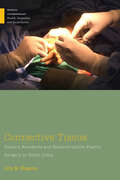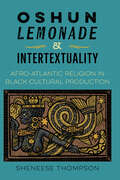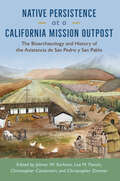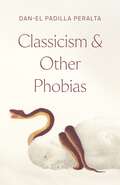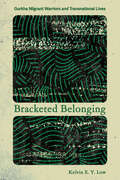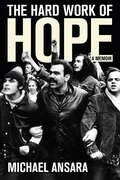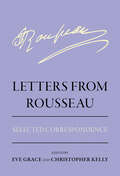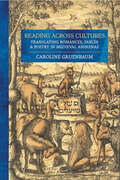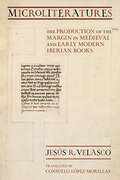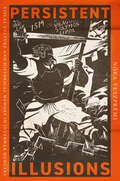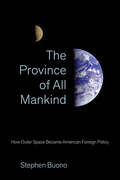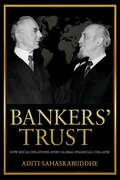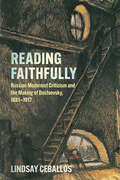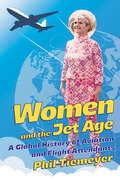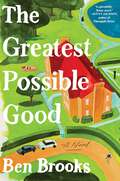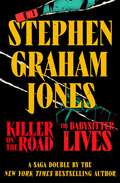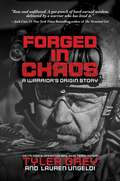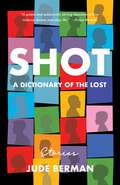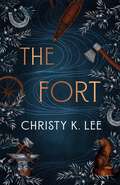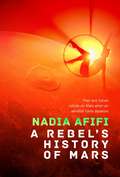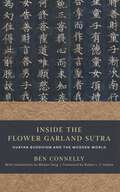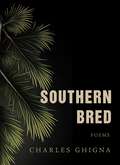- Table View
- List View
Connective Tissue: Factory Accidents and Reconstructive Plastic Surgery in South India (Medical Anthropology)
by Lily N. ShapiroAn ethnography of factory accidents and their attendant reconstructive plastic surgeries in Coimbatore, Tamil Nadu, Connective Tissue explores notions of risk, work and labor practices, and the way meaning is made from experiences of trauma, care, and recovery. The book charts a rough chronology of the accident—from the workspace that preceded it, the transformation of the workspace by the accident, through journeys to and treatment in the hospital, and then the various and complex ways in which the accident reverberates into the future during recovery. Connective Tissue revisits scholarship on factory labor by analyzing the accident as constitutive of the experience of work itself, and it refines existing conversations about the body, trauma, and care by introducing an analysis informed by theories of labor and production. Author Lily N. Shapiro argues that care does not happen in spite of or on the margins of capitalism, but rather that capitalism happens in and through care and caring relations. These experiences are intersected by identities of caste, class, and gender, and entangled in state discourse about labor rights, welfare, and industrial law.
Oshun, Lemonade, and Intertextuality: Afro-Atlantic Religion in Black Cultural Production
by Sheneese ThompsonExploring how Afro-Atlantic religion has been used to portray Black womanhood by writers and artists from Beyoncé to Ntozake Shange In this book, Sheneese Thompson analyzes works of film and literature to explore how Afro-Atlantic religion intersects with themes of resilience in Black femininity and womanhood. Focusing on Beyoncé’s visual album Lemonade, Thompson examines iconography of the Yoruba goddess Oshun, represented by rivers, the color yellow, and other symbols. Thompson argues that Beyoncé’s tribute to Oshun creates a narrative of self-repossession amid external definitions, generational trauma, and emotional violence and draws connections to other works that feature similar religious references. Oshun, “Lemonade,” and Intertextuality also explores Beyoncé’s album Black Is King, the television series She’s Gotta Have It, Julie Dash’s movie Daughters of the Dust, Ntozake Shange’s novel Sassafrass, Cypress & Indigo, and Jamaica Kincaid’s stories in At the Bottom of the River. These works highlight the significance of African traditional religions for the healing and transformation of their characters. Thompson discusses the ways in which Yoruba and Lucumí imagery and practices such as oríkì, or praise poetry, have long been incorporated into Black cultural texts such as these to tell stories of racial and gender-based injustices. In looking at Lemonade together with influential older texts created by Black women, Thompson establishes the use of Afro-Atlantic religion—to think through Black womanhood, to explore self-defined sexuality—as a central tenet of Black women’s literature, one that these artists and writers have brought to the global stage. Publication of this work made possible by a Sustaining the Humanities through the American Rescue Plan grant from the National Endowment for the Humanities.
Native Persistence at a California Mission Outpost: The Bioarchaeology and History of the Asistencia de San Pedro y San Pablo
by Lee M. Panich Jelmer W. Eerkens Christopher Canzonieri Christopher ZimmerCollaborative research revealing the lives of Ohlone individuals buried at an eighteenth-century Spanish mission outpost Construction work in 2016 at Sanchez Adobe Park, the site of a historic Spanish mission outpost in the San Francisco Bay Area, led to the surprising discovery of human skeletal remains. This book presents a series of bioarchaeological studies done in collaboration with the Amah Mutsun Tribal Band of Mission San Juan Bautista, the state-appointed Most Likely Descendants of the Ohlone people buried in this cemetery, to explore persistence and change in the lives of Native Californians recruited into the Spanish missions during the late 1700s. This volume presents cutting-edge research techniques used to study the health, diet, social connections, and medicinal practices of these Ohlone individuals. Studies include obsidian and glass bead sourcing, osteological and paleopathological analysis, stable isotope analysis, and proteomic studies of dental calculus. By comparing these findings with historical records, researchers are even able to identify several of the individuals by name and reconstruct their life histories. This volume reveals continuity in some traditional Ohlone behaviors as well as new practices influenced by the Spanish. It offers unique insights into the experiences of Native communities during early colonization on California’s Pacific coast. It also serves as a key example of collaborative bioarchaeological research carried out by a tribal community, a local parks department, and both professional and academic archaeologists.Contributors: Diana Malarchik | Kristen Broehl-Droke | Alyson Caine | Beth Armstrong | Glendon Parker | Anna Berim | Shannon Tushingham | Alan Leventhal | Tammy Buonasera | Christine Marshall | Michelle Zimmer | Monica Arrellano | Austin Cole | Tanya Smith | David Gang | Ramona Garibay | Jason Miszaniec | Melody Tannam | Kyle Burk | Mario Zimmermann | Christine Austin
Paranatures in Culinary Culture: An Alimentary Ecology
by Thomas R. ParkerUncovering the intricate cultural threads that inform our dietary practicesParanatures in Culinary Culture embarks on a gastronomic odyssey, redefining foods we thought we knew and revealing the extraordinary stories of ordinary ingredients and the cultural forces shaping our diets. The book begins with a simple premise: to eat is to assimilate the outer world into the inner body, both physically and mentally. But what happens when this assimilation process goes awry? Thomas R. Parker reveals how culinary staples are not only elements of identity formation but also instruments of cultural disruption when their true nature emerges and challenges our preconceptions. Parker explores how certain foods—bread, oysters, pigs, cheese, and wine—can both create and destabilize narratives, unsettle assimilation, and decenter Western culinary traditions. Taking inspiration from architectural historian David Gissen&’s concept of &“subnature&” and Michel Serres&’s idea of the &“parasite,&” Parker develops the concept of paranatures: flavors, foods, and practices considered unpalatable by different societies at different times. He reveals how certain ordinary foods live parallel paranatural lives, addressing larger issues of colonial and postcolonial food theory and challenging long-held notions that cuisine was meant to uphold. Serving up a rich blend of history, culture, and gastronomy, Parker leads readers to perceive food as an adventure, inviting them to taste the untamed side of nature. He offers a thought-provoking invitation to reconceptualize the roles and narratives we assign to the natural world and its produce, allowing us to see food, nature, and ourselves in new ways.
The Racial Cage (Forerunners: Ideas First)
by Nadine Ehlers Anthony Ryan Hatch Anne Pollock Amade Aouatef M'charekThe potential of biohumanities as a foundation for antiracist critique of the humanThe Racial Cage delivers a spirited and polyvocal analysis of how race is materialized through both metaphorical and literal cages. It theorizes the cage, fence, dragnet, and tube as material–semiotic sites for racialization and for iteratively redefining the human–animal boundary. A collaborative conversation across continents, this work examines the racial cage as an important part of the practice of social division and bodily containment. The deeply considered result is an empirical and theoretical approach to biohumanities that productively interrogates its linkages to critical theories of race and racism.
Classicism and Other Phobias
by Dan-el Padilla PeraltaA provocative case for why immortalizing Greek and Roman culture as &“classical&” marginalizes and devalues Black lifeGreek and Roman antiquity has been enshrined in disciplines and curricula at all levels of education, perpetuating what the historian of political thought J.G.A. Pocock has called &“a conceptual dictatorship on the rest of the planet.&” Classicism and Other Phobias shows how the concept of &“classicism&” lacks the capacity to affirm the aesthetic value of Black life and asks whether a different kind of classicism—one of insurgence, fugitivity, and emancipation—is possible.Engaging with the work of Sylvia Wynter and other trailblazers in Black studies while drawing on his own experiences as a Black classicist, Dan-el Padilla Peralta situates the history of the classics in the racial and settler-colonialist settings of early modern and modern Europe and North America. He argues that immortalizing ancient Greek and Roman authors as &“the classical&” comes at the cost of devaluing Black forms of expression. Is a newfound emphasis on Black classicism the most effective counter to this phobia? In search of answers, Padilla Peralta ranges from the poetry of Juan de Castellanos to the writings of W.E.B. Du Bois and paintings by contemporary artists Kehinde Wiley and Harmonia Rosales.Based on the prestigious W.E.B. Du Bois Lectures delivered at Harvard University, Classicism and Other Phobias draws necessary attention to the inability of the classics as a field of study to fully cope with Blackness and Black people.
Bracketed Belonging: Gurkha Migrant Warriors and Transnational Lives (Police/Worlds: Studies in Security, Crime, and Governance)
by Kelvin E. LowBracketed Belonging addresses how nations and their governance of security determine social constellations and shape socio-political and legal assertions of belonging and allegiance. Kelvin E. Y. Low examines the contours and limits of belonging that underlie the complex social contract between mobile migrants and nations in the context of a global military-security market. He explores these core themes through the case of Nepali Gurkhas and their families as military and paramilitary migrants. Recruited to serve in the military or police force, Gurkhas are trained in jungle warfare skills that other police groups do not possess. There is thus the professional link to military training and the formation of a unique paramilitary police force with the backdrop of colonialism. In these contexts, this book offers fresh perspectives on studying global security, migration and diasporic lives. It sets a new agenda by analytically bridging empire, military and security maneuvers, and migratory pathways and options. In doing so, Bracketed Belonging serves as a novel contribution to current scholarship on migration and transnationalism, and on police and security studies.
The Hard Work of Hope: A Memoir
by Michael AnsaraThe Hard Work of Hope takes you into the heady days of 1960s and 1970s activism, chronicling the hopes and strategies of the young people who created the movements that rocked the country.Michael Ansara was on the front lines. In this fascinating memoir, he traces an arc of discovery: from the hope and moral clarity of the Civil Rights Movement to the ten-year struggle to end the war in Vietnam, with its sit-ins, marches, confrontations, and antiwar riots. Ansara takes the reader into the minds of the activists detailing their successes as well as their mistakes. The Hard Work of Hope shows how he learned to become a more effective organizer and build the Massachusetts Fair Share organization. The book explores issues that remain urgent. How does a movement build support when large parts of the country are opposed to its goals? How do you connect with people who disagree with you? How do you build organizations that unite across racial lines? How can we make progress on the unfinished business of the hard work of hope?
Letters from Rousseau: Selected Correspondence (Agora Editions)
by Eve Grace Christopher KellyLetters from Rousseau is the first extensive collection of translations of Rousseau's correspondence into English in more than eighty years. Many of the letters have not been translated before, while others address substantive issues in his thought and complement his published writings. Although these letters went through the post as ordinary letters, once Rousseau became famous, he knew that they might be opened by the police and that they were very likely to be circulated and even published. Indeed, he wrote some of them with a view to their ultimate publication.Rousseau's enormous "private" correspondence extends into all periods of his life, including intimate letters to friends, letters to famous individuals, and responses to readers who posed philosophic questions to him. Thus, Eve Grace and Christopher Kelly also share his responses to readers who had been moved by his books. Further, this volume includes letters written to or about major intellectual figures, such as Diderot, Voltaire, Hume, and Mirabeau.
Reading across Cultures: Translating Romances, Fables, and Poetry in Medieval Ashkenaz
by Caroline GruenbaumReading across Cultures explores a body of innovative Jewish literary works from the Middle Ages. In late twelfth- and thirteenth-century Ashkenaz—the Jewish communities in northern France, Germany, and England—Jewish authors translated several Old French and German stories into Hebrew. These stories are distinctly non-Jewish, drawing on the Christian romances of King Arthur and Alexander the Great and the classical fables of Aesop.Caroline Gruenbaum argues that these translations—rather than adapting stories that reflected Jewish religious or cultural practice—represent a body of secular Hebrew literature in Ashkenaz and evidence of a shared literary culture between Jews and Christians in medieval Europe. Reading Hebrew animal fables, folktales, and chivalric romance, Gruenbaum describes an intellectual climate that allowed the literati of medieval Ashkenaz to read across cultures. In these translations, produced by medieval Jews for entertainment and for wisdom, Gruenbaum finds a new literary awakening in Ashkenaz.
Microliteratures: The Production of the Margin in Medieval and Early Modern Iberian Books (Medieval Societies, Religions, and Cultures)
by Jesús R. VelascoMicroliteratures is an innovative examination of writings done in the margins of medieval manuscripts and early modern books. Not always as formal as glosses, sometimes feverish and abbreviated, these marginal writings or, "microliteratures," are the product of readers thinking with the text at the center of the page. Jesús R. Velasco argues that microliteratures are not private annotations but, rather, a humanistic activity performed in the public sphere. These marginal engagements with texts are made public to future readers of the same book. Surveying the microliteratures of a wide range of medieval and early modern Iberian genres—legal, religious, chivalric, and political texts—Velasco finds that in the shared space and time of reading, microliterary actions and artifacts are also models of public humanities work that connects texts to contemporary issues. Microliteratures emerge from this ambitious book as a way of understanding the self as a reflective and politically engaged reader in conversation with past, present, and future readers as contemporaries.
Persistent Illusions: Visual Culture and Historical Memory in Interwar Hungary
by Nóra VeszprémiPersistent Illusions examines the visual representation of history in interwar Hungary, where interpretations of the past were suffused with references to the country's recent territorial loss. In these images of history, nineteenth-century themes and motifs took on new forms to promote twentieth-century political ideas through the new media of modernity.Nóra Veszprémi illustrates how modernization created resilient imagery that persists in cultural memory through a wide range of paintings, prints, stamps, public spectacles, and monuments. In doing so, she challenges the assumption that the official culture of the right-wing, authoritarian regime of Admiral Miklós Horthy was characterized by a superficial revival of historical styles. Instead, she argues that the regime drew on history in complex, modern ways that disseminated motifs and ideological frameworks across political divides. By analyzing how ideology shapes enduring concepts of the past through the evocative power of images, Persistent Illusions encourages the reader to critically examine the legacies of interwar ideas and imagery in the present day.
The Province of All Mankind: How Outer Space Became American Foreign Policy
by Stephen BuonoThe Province of All Mankind is the story of a powerful idea about the cosmos. Born in the science-fiction literature of the nineteenth century and maturing in the Age of Apollo, this idea held that outer space should be preserved as a "sanctuary" from human strife, free from weapons, warfare, and political rivalry. If humanity could somehow leave violence behind as it moved into space, perhaps peace would finally reign. Bucking a half-century of "space race" scholarship, Stephen Buono argues that despite waging a totalizing Cold War, the United States achieved stunning diplomatic successes that heralded the cosmos as a realm of peace and cooperation. The early story of space politics is not primarily one of militarization, but rather of political prescience and restraint. The Province of All Mankind demonstrates that space became a unique domain of American foreign relations and international law, and provides lessons for the Second Cold War unfolding over the horizon.
Bankers' Trust: How Social Relations Avert Global Financial Collapse (Cornell Studies in Money)
by Aditi SahasrabuddheIn Bankers' Trust, Aditi Sahasrabuddhe reveals a crucial element behind the resolution of global financial crises: trust between central bank leaders. Central bank cooperation during global financial crises has been anything but consistent. While some crises are arrested with extensive cooperation, others are left to spiral. Going beyond explanations based on state power, interests, or resources, Sahasrabuddhe argues that central bank cooperation—or the lack thereof—often boils down to ties of trust, familiarity, and goodwill between bank leaders. These personal relations influence the likelihood of access to ad hoc, bilateral arrangements with more favorable terms. Drawing on archival evidence and elite interviews, Sahasrabuddhe uncovers just how critical interpersonal trust between central bankers has been in managing global financial crises. She tracks the emergence of such relationships in the interwar 1920s, how they helped prop up the Bretton Woods system in the 1960s, and how they prevented the 2008 global financial crisis from turning into another Great Depression. When traditional signals of credibility fell short during these periods of crisis and uncertainty, established ties of trust between central bank leaders mediated risk calculations, alleviated concerns, and helped innovate less costly solutions.Sahasrabuddhe challenges the idea that central banking is purely apolitical and technocratic. She pinpoints the unique transnational power central bank leaders hold as unelected figures who nonetheless play key roles in managing states' economies. By calling attention to the influence personal relationships can have on whether countries sink or swim during crises, Bankers' Trust asks us to reconsider the transparency and democratic accountability of global financial governance today.
Reading Faithfully: Russian Modernist Criticism and the Making of Dostoevsky, 1881–1917 (NIU Series in Slavic, East European, and Eurasian Studies)
by Lindsay CeballosReading Faithfully reveals how Russian critics of the Silver Age (the late nineteenth and early twentieth centuries) reread and remade Fyodor Dostoevsky for their era of religious renewal amid a broader political embrace of liberal reform and radical politics. Lindsay Ceballos argues that most Silver Age critics engaged in a mode of critique approaching religious faith: critical faith in the moral and artistic value of Dostoevsky that was needed to overcome their doubts about his nationalist rhetoric and politics. Surveying leading critics on and theatrical adapters of Dostoevsky's fiction since his death in 1881, Ceballos advocates for new kinds of critical engagement with his work that draw on the example of Silver Age faithful reading but embrace more complexity and dissonance than critics were able to achieve in that period of fracture and upheaval.Reading Faithfully provides a historical account of Russian culture in a pivotal period, bringing together literary, intellectual, and theater history into one narrative. Ceballos challenges Dostoevsky scholars, asking: What is the future of reading Dostoevsky in the wake of Russia's invasion of Ukraine?
Women and the Jet Age: A Global History of Aviation and Flight Attendants
by Phil TiemeyerWomen and the Jet Age is a global history of postwar aviation that examines how states nurtured airlines for competing political and economic goals during the Cold War. While previous histories almost exclusively stress US and Western European aviation progress, Phil Tiemeyer examines how smaller, poorer states in socialist Eastern Europe and in the postcolonial Global South utilized airlines of their own to forge rival pathways to modernization.Part of this modernization involved norms for working women. Stewardesses at airlines around the globe encountered novel threats to their dignity as the Jet Age approached. By the late 1960s, stewardesses endured harsh objectification: High hemlines, tight uniforms, and raunchy marketing were touted as modern and liberated. These women, whether from the West, East, or South, forged their own pathways to achieve greater dignity at work. In Women and the Jet Age, Tiemeyer's global account of the rise of air travel and of early feminist strivings among stewardesses is one of the first histories to place such developments—political, economic, and feminist—in dialogue with each other.
Millennial Menopause: Preparing for Perimenopause, Menopause, and Life's Next Period
by Lauren A. TetenbaumGet ready to learn the new way to take on menopause with this refreshingly real guide for millennials looking to embrace a challenging life phase with confidence, humor, and empowerment.Menopause is often misunderstood, under-discussed, and even stigmatized. For millennial women, navigating this next chapter may seem daunting. How can you find surety and balance within all of the noise? How can you pinpoint what is an old wives&’ tale and what is fact based in modern science? In Millennial Menopause, this generation finally has the handbook it deserves—a fresh, relatable, and empowering guide to understanding modern menopause. From hormonal changes and mental health to the impact on careers, sex lives, and friendships, Millennial Menopause covers it all. With real-life anecdotes, professional advice, and important discussions on how menopause is (and isn&’t) portrayed in the media, this book encourages millennial women to advocate for themselves, embrace their bodies, and navigate this phase with confidence. Whether you're just starting to wonder "What&’s next?" or already feeling the effects, this book offers practical tips, expert interviews, and a much-needed sense of sisterhood. After all, this isn't just the end of one chapter—it's the beginning of an empowered new era.
The Greatest Possible Good: A Novel
by Ben Brooks&“A sharp-witted tragicomedy about money, morality, and a family teetering on the brink. A splendidly funny novel.&” —Jenny Jackson, New York Times bestselling author of Pineapple Street For readers of Paul Murray&’s The Bee Sting and Jenny Jackson&’s Pineapple Street, an irresistibly funny and incisive novel about a wealthy family that is confident in its good intentions—until the discovery that their patriarch has secretly given all their money to charity ruins their lives.Meet the Candlewicks. Seventeen-year-old Evangeline (a.k.a Dubbin), wants to change the world, has a penchant for throwing fake blood during protests, and despairs at the smug complacency of the rest of her family. Emil is fifteen, and a painfully shy math prodigy who has just begun dabbling in narcotics. Their mother, Yara, arrives at airports four hours early and fears that AI and climate change will leave her children unemployed and unable to go outside for longer than ten minutes. And, Arthur, the father, a hapless and always neutral man, who can&’t decide if he is a good person or a doormat—forgiving and understanding or weak and terrified. Their comfortable lives are thrown into disarray when Arthur walks out into the woods one night for a stroll in his calfskin slippers only to fall down an abandoned mineshaft. Disoriented and unable to move, he remains there for three days with only a bottle of mid-range Bordeaux, his son&’s confiscated stash of LSD, and his daughter&’s book on the concept of Effective Altruism for company. When he is rescued, he is a man transformed. Determined to give away all of his wealth and devote the rest of his life to the (statistically proven) most worthy causes, his metamorphosis shocks his family and triggers a chain of events that will have far-reaching and unforeseen consequences for them all. Equal parts hilarious and achingly human, The Greatest Possible Good spans ten years in the lives of the Candlewicks, asking universal questions about what it means to live a good life and if there is a &“right&” way to be a good person, while introducing the world to one of the most memorable and dysfunctional families in contemporary literature.
Killer on the Road / The Babysitter Lives (Saga Doubles)
by Stephen Graham JonesA must-have collector&’s item for horror fans, comprised of two novels, The Babysitters Lives and The Killer on the Road, from the new master of horror Stephen Graham Jones.The Babysitter Lives When high school senior Charlotte agrees to babysit the Wilbanks twins, she plans to put the six-year-olds to bed early and spend a quiet night studying: the SATs are tomorrow, and checking the Native American/Alaskan Native box on all the forms won&’t help if she chokes on test day. But tomorrow is also Halloween, and the twins are eager to show off their costumes. Charlotte&’s last babysitting gig almost ended in tragedy when her young charge sleepwalked unnoticed into the middle of the street, only to be found unharmed by Charlotte&’s mother. Charlotte vows to be extra careful this time. But the house is filled with mysterious noises and secrets that only the twins understand, echoes of horrors that Charlotte gradually realizes took place in the house eleven years ago. Soon Charlotte has to admit that every babysitter&’s worse nightmare has come true: they&’re not alone in the house. The Killer on the Road Sixteen-year-old Harper has decided to run away from home after she has another blow-out argument with her mother. However, her two best friends, little sister, and ex-boyfriend all stop her from hitchhiking her way up Route 80 in Wyoming by joining her on an intervention disguised as a road trip. What they don&’t realize is that Harper has been marked by a very unique serial killer who&’s been trolling the highway for the past three years, and now the killer is after all of them in this fast-paced and deadly chase novel that will have your heart racing well above the speed limit as the interstate becomes a graveyard.
Forged in Chaos: A Warrior's Origin Story
by Tyler Grey Lauren UngeldiForged in chaos, shattered in peace: What happens when the war doesn&’t end, it just moves inside your head?Tyler Grey was the epitome of the warrior archetype: a Delta Force operator, a master of counterterrorism. He hunted the worst bullies on the world&’s playground—high-value targets, bomb makers, warlords—executing covert missions that never made the news. He had perfected the persona—ruthless, efficient, untouchable—until one mission in Sadr City, Iraq changed everything.&” On what should&’ve been a routine raid, an explosion ripped through the home shattering more than just flesh and bone; it fractured his identity. Stripped of everything that defined him, Tyler reached for chaos: sex, substances, a romance that was either a love worth fighting for or his ultimate kryptonite. But beneath it all, the hunger for chaos never died. He was built for it. Without it, his body rebelled, his mind fractured, and the war turned inward. In this raw, antiheroic tale, Tyler dissects his life, exposing the unseen war within and exploring the question: What happens when the very abilities that made you a superhero in the eyes of the world turn you into a supervillain in your own life? Despite rising PTSD awareness, we&’re losing more warriors at home than in war. Such a devastating reality begs the question: What if we&’ve fundamentally misunderstood this disease? This book doesn&’t challenge the narrative; it destroys it, laying bare the cost of being forged in chaos. This isn&’t a war story. It isn&’t a tribute to sacrifice or a highlight reel of heroics. Forged in Chaos rips the mask off the warrior experience, exposing the truth that most never dare to face: The fight isn&’t over. And this time, the enemy isn&’t out there—it&’s within.
Shot: A Dictionary of the Lost
by Jude BermanAn acclaimed author&’s collection of short stories for fans of genre-bending fiction, Shot blends social impact fiction and activist fiction, tackling the gun violence crisis head on.Anna argues with her mom about a school science award. Ben discovers in his seventh decade that he is Jewish. Chester searches for his little sister in a snowstorm. Dixie is pregnant with her second child. Their stories and twenty-two others read like the ABC&’s of everyday life. One way or another, the challenges that bring drama to our lives work themselves out, right? Or maybe not. Sometimes the ending isn&’t at all what you expect. Shot is a collection of short stories about gun violence, organized as a dictionary, with a story for each letter of the alphabet. Each life is precious. And life itself is to be celebrated.
The Fort
by Christy K. LeeFor fans of Genevieve Graham, The Fort transports readers to the rugged Canadian fur trade era, where a resilient single mother defies conventions to forge a new life on the frontier.It's the height of the fur trade in Canada, and Abigail Williams leaves her home in England and travels deep within the rugged wilderness to escape her scandalous past. With her young son in tow, Abby imagines a life on the banks of the North Saskatchewan River, in the rugged but beautiful Fort Edmonton, where she can mend horseshoes in her father&’s blacksmith shop and her past will not be a hindrance to her happiness. Life has other plans. The interest of Henry, an officer at the fort, and Gabriel, a French trapper, are not what she expected. While she wrestles with what future either man can give her, her past comes to haunt her, and she and her son must flee with a ragtag group of voyageurs to Montreal. The winter journey is fraught with dangers, from raging rivers to the chaos that is Lake Superior. But Abby is determined to create a new life for herself, whatever the barriers. The Fort features the iconic Hudson's Bay Company and rival North West Company, English-French tensions, a heartfelt love story, LGBTQ+ representation, and impeccably-researched historical detail.
A Rebel's History of Mars
by Nadia AfifiRocky Mountain Fiction Writer member's striking new book of time travel and biological science fiction is a thrilling ride.Kezza, an aerialist in the Martian circus, can never return to Earth – but she can assassinate the man she blames for her grim life on the red planet. Her murderous plans take an unexpected turn, however, when she uncovers a sinister secret. A thousand years into the future, Azad lives a safe but controlled life on the beautiful desert planet of Nabatea. His world is upended when he joins a crew of space-traveling historians seeking to learn the true reason that their ancestors left Mars. Separated by time and space, Kezza and Azad&’s stories collide in the Martian desert.
Inside the Flower Garland Sutra: Huayan Buddhism and the Modern World
by Ben ConnellyA Soto Zen teacher explores the core teachings of the ancient Huayan school of Buddhism through an innovative and engaging collection of essays showing how to put these teachings into practice.Huayan Buddhism arose in the sixth century and was rooted in the Mahayana Flower Garland Sutra. The teachings of Huayan had a profound influence on Chan and Zen. Huayan is relational, practical, and positive. Its emphasis on interdependence, celebration of the sensual world, and diversity of people and practices provides inspiration for what Thich Nhat Hanh called &“engaged Buddhism." With Inside the Flower Garland Sutra, Zen teacher Ben Connelly explains the significance of Huayan teachings for Buddhist practice. Each chapter is a commentary on one of the thirty lines of Uisang&’s &“Song of Dharma Nature&”—a seminal Korean text that summarizes Huayan thought—thus providing a broad overview of Huayan teachings and their practical implications for contemporary life, with a mix of testimonies from real-life situations and references to influential Buddhist texts. Arising fifteen hundred years ago, Huayan has made a deep impact on East Asian Buddhism, and has much to offer during this era when many folks see ever-deepening divisions. Connelly explores how Huayan offers particular wisdom for those concerned about how to care for their own lives as they work to end harms such as ecological devastation, poverty, militarism, addiction, marginalization, and exploitation.
Southern Bred: Poems
by Charles GhignaDiscover the captivating allure of the Deep South through the haunting and powerful verses of one of today's most accomplished poets.Southern Bred is a haunting, powerful collection of gothic poems that captivate and transport the reader into the heart and soul of the Deep South. Each poem offers a glimpse into its mystery and enchantment, drawing you in with a blend of beauty and darkness. In the style of a memoir in verse, it showcases Ghigna's southern soul and his tender, yet piercing language, and affirms his place as one of the finest poets of our time.
